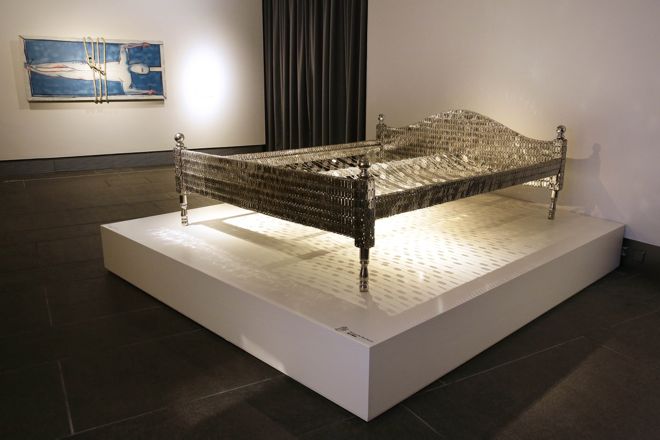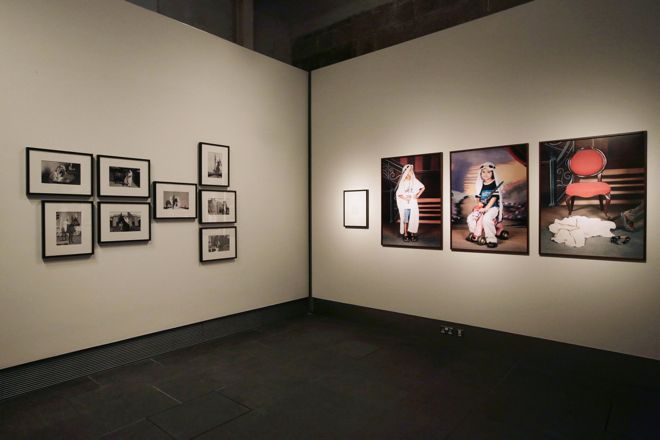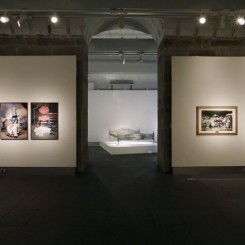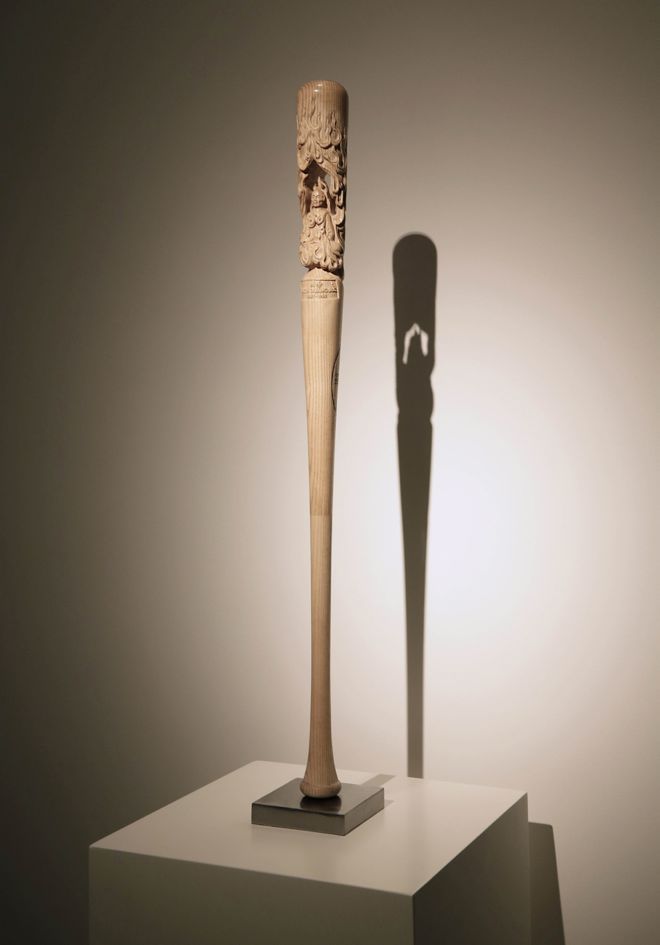No Country: Contemporary Art for South and Southeast Asia
Asia Society (9 Justice Drive, Admiralty, Hong Kong) Oct 30, 2013–Feb 16, 2014
In practical terms, the past five years have seen Hong Kong shift from a tertiary hub for Chinese art to a tertiary hub for international contemporary art: witness the closure or downsizing of galleries like Schoeni, Plum Blossoms and Alisan alongside the arrival of Gagosian, White Cube and Perrotin, not to mention the hibernation of the Hong Kong Museum of Art in contrast with the establishment of M+ in West Kowloon. On a symbolic level, however, Hong Kong is increasingly called upon to bear the weight of all “Asia” within an international system: the Asia Art Archive has expanded its core focus from China to East and South-East Asia; the Asia Society has established a branch center; the magazine Art Asia Pacific has relocated its editorial office from New York to Hong Kong and Christie’s and Sotheby’s tout sale categories like “Asian 20th Century and Contemporary Art,” selling Chinese modernism alongside Philippine paintings straight from the studio. It is easy, perhaps, to forget that Hong Kong is not to Asia what Brussels is to Europe. It is, however, a very convenient place to register a business, particularly when proximity to Chinese money is a concern.
If, for many of these organizations, the label “Asia” is simply an inclusive-sounding stand-in for “China,” curator June Yap’s ongoing exhibition at the Asia Society offers a bit of balance. Organized for the Guggenheim Museum program MAP Global Art Initiative—which has been widely criticized for breaking down the scholarly work of its interlocutors along the geographic lines of the emerging markets in which banks like UBS, the sponsor for the entirety of this initiative, are increasingly seeking and discovering quantities of new clients—the exhibition travels to Hong Kong after an initial outing on the Upper East Side, albeit with a divergent selection of works. The title, however, remains: “No Country: Contemporary Art for South and Southeast Asia.” Broad beyond belief, even, in cultural terms, in comparison with the millennia-spanning survey “China: 5,000 Years” or the more standard national survey shows still favored by mid-sized institutions today, this remit is both ambitious and impossible. Its participle, “for,” is telling, as it has been a stylish choice for several years now, replacing the more extractive (read: imperial) logic of “from” with the fully prescriptive (read: colonial).

Installation shot (left to right): Truong Tan, “What do We Want,” 1993-94 (b.1963, Hanoi, Vietnam) and Tayeba Began Lipi (b.1969, Gaibandha, Bangladesh) “Love Bed”, 2012. (Photographed on October 27, 2013 by Jessica Hromas)
Yap’s premise—the proposal of a transnational sphere spanning these massive regions—seems tenuous given that few, if any, of the works in the exhibition have much to say to one another, and fewer seem to be particularly interested in cosmopolitanism or, for that matter, any kind of international language. Except, that is, for the language of identity politics, which appears to have crawled back from the dead with a vengeance. This exhibition collects work that belongs exclusively to a very peculiar set of genres: the execution of contemporary tropes with traditional craft; the poetic visual metaphor for identity and the portrayal of conflicting (usual modern and traditional, international and local) identities through the materials, if not the concerns and histories, of contemporary art. Extracting so many similar positions from a variety of more or less enclosed art histories does little other than to lay bare the lack of personality in so much of this work. While these artists are significant and influential within narrow trajectories, outside these particular historical contexts the work can only weakly signify its own regional identity. At a moment in which contemporary art, including practitioners in Manila, Bangkok, Singapore and Mumbai, among many other places, seems to be coming to terms with the power of the object and the gesture as mechanisms to cope with the shifting possibilities of the dissemination of culture and media, this constellation of practices reads like a painful throwback to the survey era.
The weakest work in the exhibition scores obvious points about the collisions of identity between such religious and other groups. Shilpa Gupta, for instance, juxtaposes a plaque listing the length of fencing along the border between Pakistan and India with a ball of thread cut to the same dimensions, reliving the perils of illustrative art to a painfully literal degree. Araya Rasdjarmrearnsook screens a video in which a figure watching television finds light-hearted soap operas embedded within documentation of political conflicts, creating a literal conflict of images that is diegetically resolved through a nostalgic soundtrack of apolitical standards. Vincent Leong presents formal portraits of Indian and Chinese minority families in Malaysia, dressed in Muslim garb and labelled as “Malay” families—a bland statement of what is lost and what is gained through the process of integration in multicultural societies. Tayeba Begum Lipi builds a bed out of razor blades, reducing real problems of gender and political violence to a symbolic statement that goes nowhere.
On the other hand, work that is able to escape the identity-based strictures of the exhibition appears much more unstable, constructing entire universes into which viewers are able to disappear, seeking not only one-off statements about identity and conflict but rather discovering new questions with few answers. Bani Abidi (who, not coincidentally, enjoys the largest installation in the exhibition), for instance, offers a suite of works revolving around Mohammad bin Qasim, the partially mythical figure who introduced Islam to the region that is now Pakistan. The politics of media distribution here are taken as rich ground for the development of fabricated mythologies that haunt the simpler questions of identity that surround them: a new convert to Islam fancies himself the quixotic figure of bin Qasim, while young children posed as bin Qasim in portrait studios simply get tired and walk away, leaving their robes in piles on the floor. Elsewhere, Vandy Rattana presents landscape photographs of “bomb ponds” in Cambodia, toxic bodies of water created by American attacks that ravaged the region. A neat metonym for the exhibition as a whole, the project is presented in a format that ultimately drains its of its basic energy. Nine large-format photographic prints hang in a row, each depicting a crater pond in the midst of fields and jungles; the sense of historical gravity is urgent but implied, impressed on the viewer through the repetitive and almost cinematic staging of scene after scene. Coming to the end of the row, however, the aesthetic weight of the work disappears as it returns to an ethnographic mode, concluded by both a documentary video and printed material explaining the intended import of the photographs and, in the process, negating their very necessity.
The volatile trajectories contained within these two expansive projects are conceptually alive and visually thrilling. This fortunately offsets the bulk of work in the exhibition, which tends too often towards the declarative rather the inquisitive. Without the proper context of a historical survey, these positions thus seem isolated and exposed, belonging more properly to the generic space of “Asian identity” (buttressed by institutions like the Asia Society), rather than the dynamic, cosmopolitan project of contemporary art to which the exhibition purportedly aspires.

Installation shot (left to right): Bani Abidi (b.1971, Karachi Pakistan) “The Ghost of Mohammed Bin Qasim”, 2006 and “The Boy Who Got Tired of Posing” 2006. (Photographed on October 27, 2013 by Jessica Hromas)

Vandy Rattana (b.1980, Phnom Penh, Cambodia) “Bomb Ponds”《炸弹池塘》, 2009. (Photographed on October 27, 2013 by Jessica Hromas)



